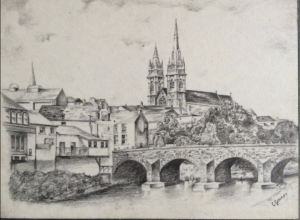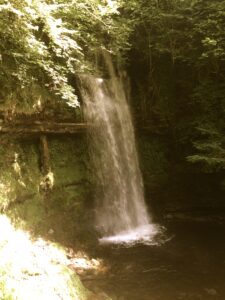There is an underlying meaning of bleakness and sadness about the word Omagh now. A layer of meaning added by people who knew nothing of the town, its past, its people, its spirit.
It’s our town. We grew up there. It was no different than other places I’m sure. But it was where we were born and raised. Lately although I no longer live there, the spirit of the town has raised itself in my mind. The utter bleakness is there of those August days but also the glimpses of a happy childhood. I feel in some way I need to reclaim them.
My son asked me the other day where I got my football boots when I was his age. I thought for a minute and replied ‘the Fairway Stores in Omagh’ and my mind flooded with memories of Frankie Bradley guffawing through his beard. With it memories of getting togged out in the dank, damp, dark dressing rooms of the Brothers Park.
At least it was better than St Pat’s Park with the flooded goalmouth and the brown stripped tree trunks for goals. Kit bags of mud caked jerseys for those brilliant Brothers primary football tournaments. Joe McElholm, Mr Farry, Harry Scully, Seamus Harkin and the boys. The craic they must have had in their staff room.
We used to leave St Colmcille’s to play football and dodge down along the side of the river Strule to get into the Park. Children would never be allowed to do that nowadays. One slip and you were in it. Never happened though.
The subject came up with my mother the other day. An Omagh woman all her life. She was raised in the Military Arms in McConnell Place, now the Hogshead. Every day she walked out to Culmore to the old primary school. She went on to the Convent. After studying at St Mary’s she returned to Omagh. My father was an Armagh man. He worked in the Brothers.
It was in Omagh that we were raised. It was our town. It was there we went to school. Like a native of any town, you know it like the back of your hand. As I grew older, I would walk through the town from the Hospital Road to my granny’s house on the Tamlaght Road. It was idyllic out there. I spent the best part of a year living with her when I was about three. Until her passing in 1987 it was where I spent some of the happiest days of my life. We ourselves lived in the shadow of the County Hospital. It was our playground. Playing ball in the square. Being chased from the Old People’s home by an oul bitch of a matron: ‘Get outta here’ she’d roar arms a flapping.
I remember summer days in the Gortin Glens, at the Lovers’ Retreat or over at the Grange Park. Doing nothing much. For a while tennis was en vogue. Later times passed as we were older, idly up the town as Arty G vied with manic street preachers for audience share. Hanging about Robert Clarke’s record shop in Bridge Street. As a cub going down to watch Omagh Town play in the Showgrounds. The likes of Chimney Corner, the RUC and Dundela the opposition. Patsy Hetherington imperious at the back. I once signed him for my Subbuteo team he was that good.
Further on up the road Omagh St Enda’s, later Healy Park. Going to watch my first Tyrone match with my brother John. It was about 1975 against Sligo. Eugene McKenna scored the goal. The ground was all grassy banks but it was like a stadium to me. I kicked ball there for Omagh and against them for Killyclogher. Won a centenary year minor championship hurling medal there. I’ve since had some great days bringing the children to Healy Park in Omagh. Happy memories of the town.
Myself and Pete McCloskey used to go fishing round the town. I was a bad fisherman but we used to land the occasional silver bellied trout. Pete’s dad one time thought we should have put a fish or two back they were that small. He didn’t know the effort we’d put in to catching them, and I enjoyed gutting and eating them. We’d wander off up to the T&F and try our luck in the dark pools up there. Peter would catch something and I’d fill the wellies with water after falling in again. But the days passed slowly as if we were doing nothing at all.
There was music in Omagh. A vigorous band scene where lads with DMs, jeans and Harringtons would thrash the life out of cheap guitars and a drum kit in the minor town hall. In the summer they would pitch up on a trailer in O’Kane Park or Strule Park at a community festival, blasting out a deadly din altogether. Other lads would stand around smoking fags and eyeing up the girls.
There’s other things about the town that flood back if you let them. Jack’s chip shop in George’s Street. Gormley’s in Castle Street. As we got older, a pint of shandy and a microwaved burger in the Cellar Bar. Discos in Knocknamoe. Nights spent in the Mecca that was the GAA with Rock Stewart, the Memories and those discos with the massive dancefloor. You’d do more laps there looking at girls than you might do in training.
The town’s bookshop, the Carlisle bookshop where the owner would give you death if you were caught reading a paper or magazine in the shop. It became cat and mouse.
Omagh. The Herald on Thursdays. The Con. Father Rooney saying mass in that soft tone of his. Sitting about on the Courthouse steps before it too was blown up. Those familiar places. The Royal Arms Mews. The Tech. Smokies. The Golden Griddle. Wellworths. John Taggart’s shoe repair shop, with that smell and your newly soled shoes in a brown paper wrapper, tied up with string. We grew up there.
That’s our town. On this day sixteen years ago the cloud descended. For all the people who were lost. For their relatives and friends. It was their town too. Still is. And the memories are just as powerful.
Our town.



